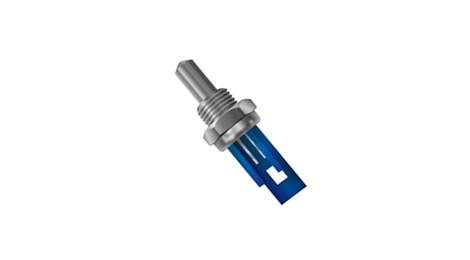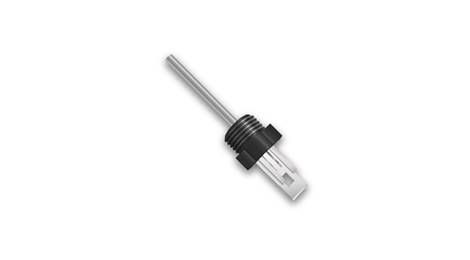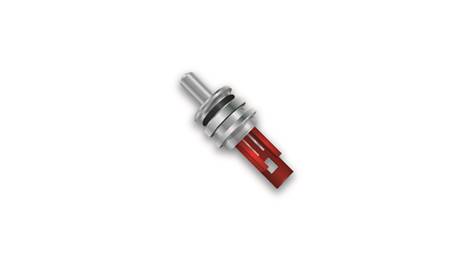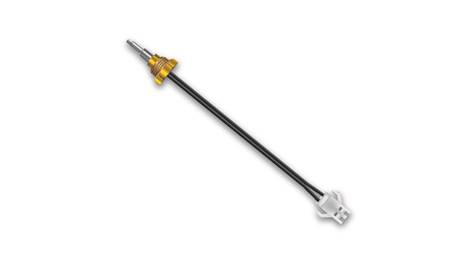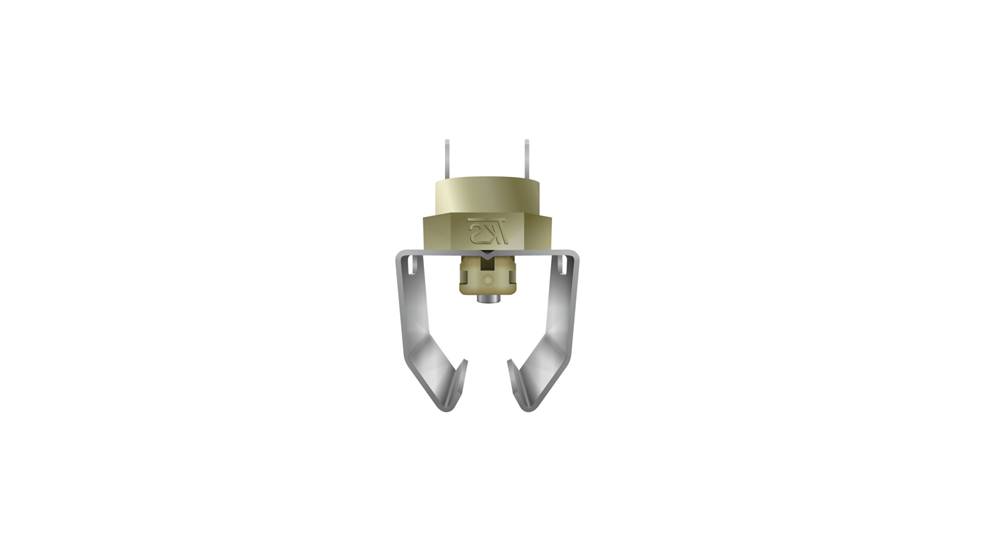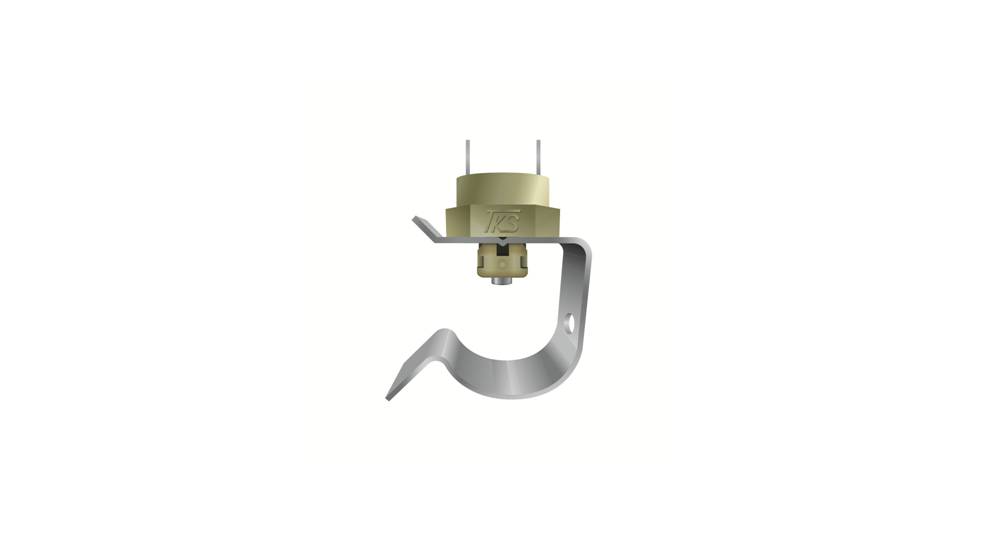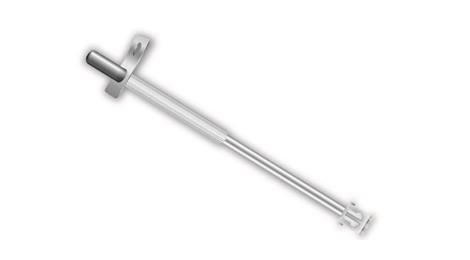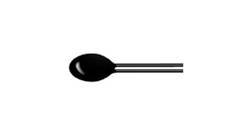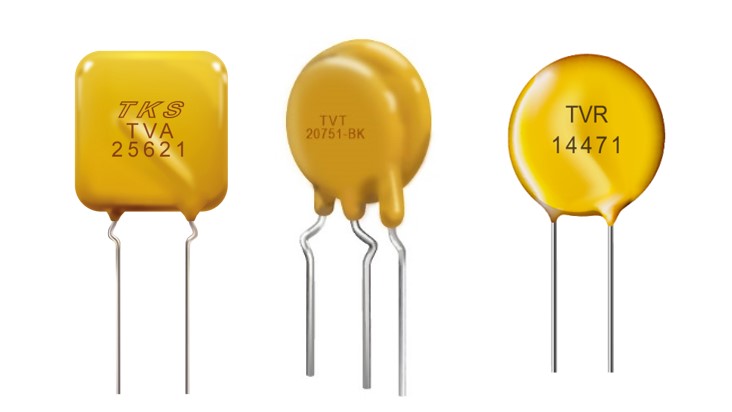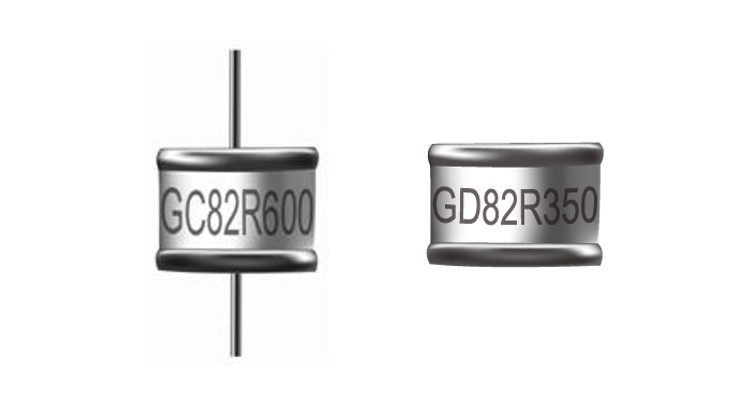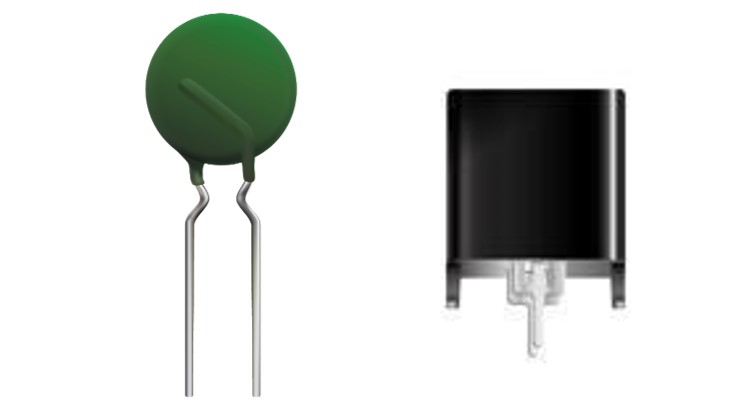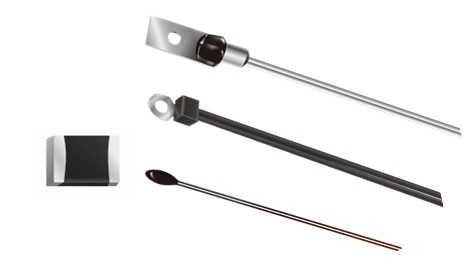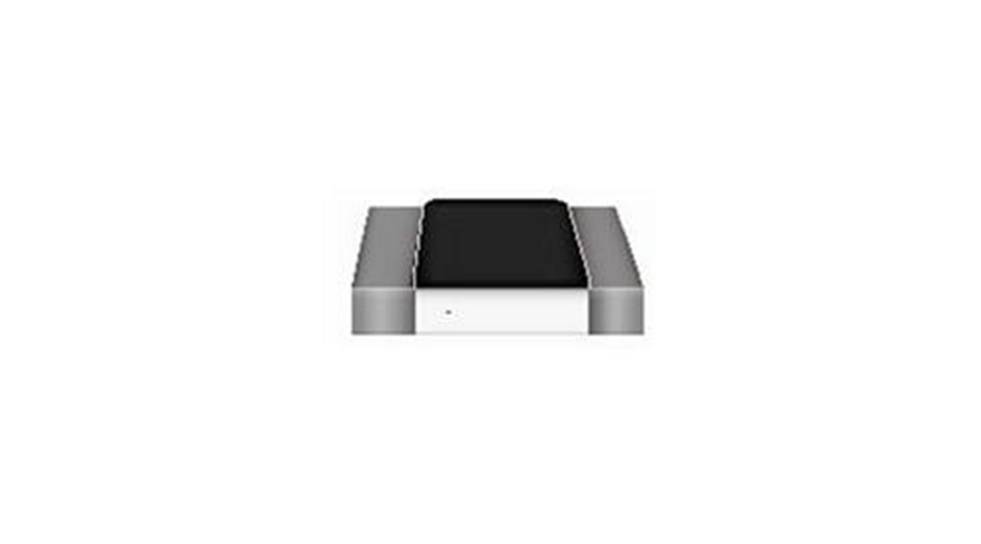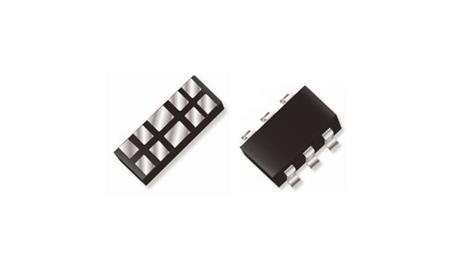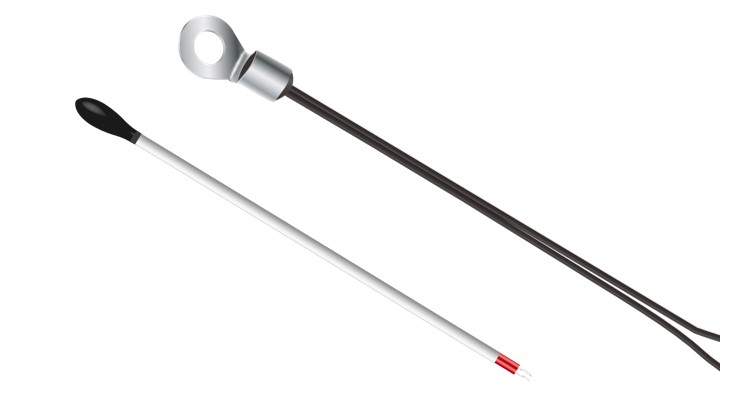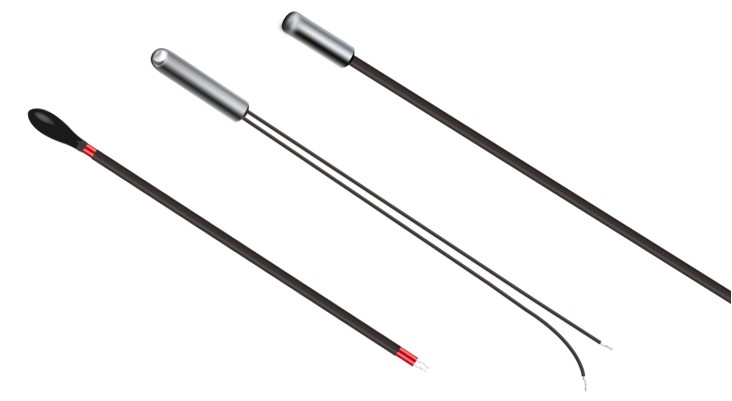Product Application
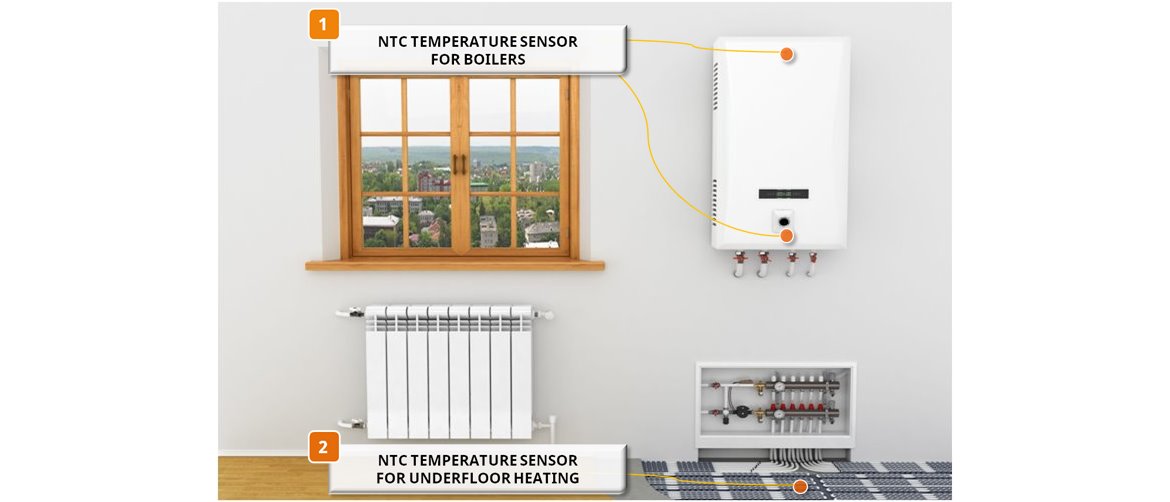
Central heating that consists of a boiler and radiators is one of the most common heating systems used in Europe and the U.S. for houses that do not have district heating. Boiler supplies space heating, domestic hot water, or both. To ensure users safety, comfort and heating efficiency, NTC temperature sensors in the boiler measures water temperature or combustion temperature for best heating control. Temperature sensors usually are placed at different points in boilers detecting temperature of flow and return pipes, of domestic hot water outlet, and of flue gas. THINKING offers NTC temperature sensors with various mounting features to fit different boiler and heating system application requirements.
for Boilers
THINKING offers a series of immersion type temperature sensors that are suitable for direct contact in the water flow or flue gases. The immersion type sensors can meet various temperature measurement and installation requirements while sharing the same benefits of accurate temperature detection, fast thermal response (thermal time constant < 3 s) , corrosion resistance, and long-term stability. They can be used to measure either water or flue gas temperature to help the controller to increase the heat or to lower temperature.
(a) Short thermal response time in water and easy to screw-in design make the NTC temperature sensor an ideal solution for pipe fluid temperature detection and control. The temperature sensor assembled in a nickel plated brass cap with a G 1/8'' thread, washer and connector, is easy to install.
(b) The small-diameter sensing top design optimizes the response time and is ideal for detecting flue gases in gas boiler. The NTC temperature sensor is assembled in a 316 stainless steel housing with a thread, O-ring and connector for fast and simple installation.
(c) The NTC temperature sensor reponds fast to temperature change and comes with push-fit mounting design, which offers an installation alternative to screw-in design.
(d) With bullet-type NTC temperature sensor mechanical design, the sensor responds relatively fast (< 2 seconds), and helps power energy saving. The fast response sensor is perfect for detecting water temperature in gas combi boiler and instant water heater to ensure user safety during hot shower. The sensor can be customized with various mounting features such as brass nut or clip to best fit your mounting requirement.
To measure the temperature of flow and return pipes, THINKING recommends the patented clip-on surface mounting temperature sensor with high moisture resistance and high accuracy. The NTC sensor placed in the tip of a small diameter brass housing enables thermal coupling to the metal pipe and thus improves response time (< 2s). The rugged spring clip is very easy to install and it allows the sensor to be secured easily to pipes. The clips can be applied to pipes with diameters of 13, 15, 18, 22, and 28 mm. The sensor is aviailable in two types of clips to meet different installation requirement.
for Boiler
The NTC temperature sensor is assembled in a 316 stainless steel housing with heat-resistant lead wire that allows the sensor to withstand a high temperature of 250°C. It responds fast to temperature fluctuation and is ideal for measuring flue gas temperature. The flange design allows simple and stable screw-on installation.
for Underfloor Heating
For houses that incorporate hydronic underfloor heating, the water is heated to a warm temperature from the boiler and circulates in a set of plastic pipes. A temperature sensor is usually mounted under the floor surface to help control the room temperature. We recommend the use of epoxy coating type NTC temperature sensor with lead wire because it is double insulated and resists to moisture. The lengths of the cable can be customized to fit the application specification.
Over-Voltage Protection
Since most AC and DC charging stations are fed AC power from the electrical grid, power surges may transmit to the charging station via the AC power input line. Furthermore, the charging stations may locate outdoors with the threats of lightning strikes or near a facility with a heavy industrial motor that may induce voltage surges. Therefore, the charging station needs a surge protection solution that can withstand high-voltage transients. THINKING provides two lightning protection solutions. For DC fast charging stations situated outdoors, it is recommended to include THINKING high-energy metal oxide varistor, TVA25 (25mm) series for lightning surge protection. For DC or AC charger placed indoors, the combination of the radial leaded type varistor of TVR series or TVT series (Ф14mm or Ф20mm) with gas discharge tubes is the ideal transient suppression solution for primary circuit.
Metal oxide varistor
● The TVA series is the metal oxide varistor designed to absorb high-surge energy produced by a lightning strike. The series is available in various forms and sizes and offers high surge current withstanding capability.
● The TVT series is the thermally protected metal oxide varistor from THINKING. It is comprised of MOV with a thermal fuse element designed to open when overheating occurs under frequent over-voltage conditions. There are two-terminal and three-terminal versions of the device. The inclusion of a third monitor lead helps indicate whether the MOV has been disconnected from the power circuit or not, making the device fail-safe.
● The TVR series provides a wide range of operating voltage, and is with high surge protection capability.
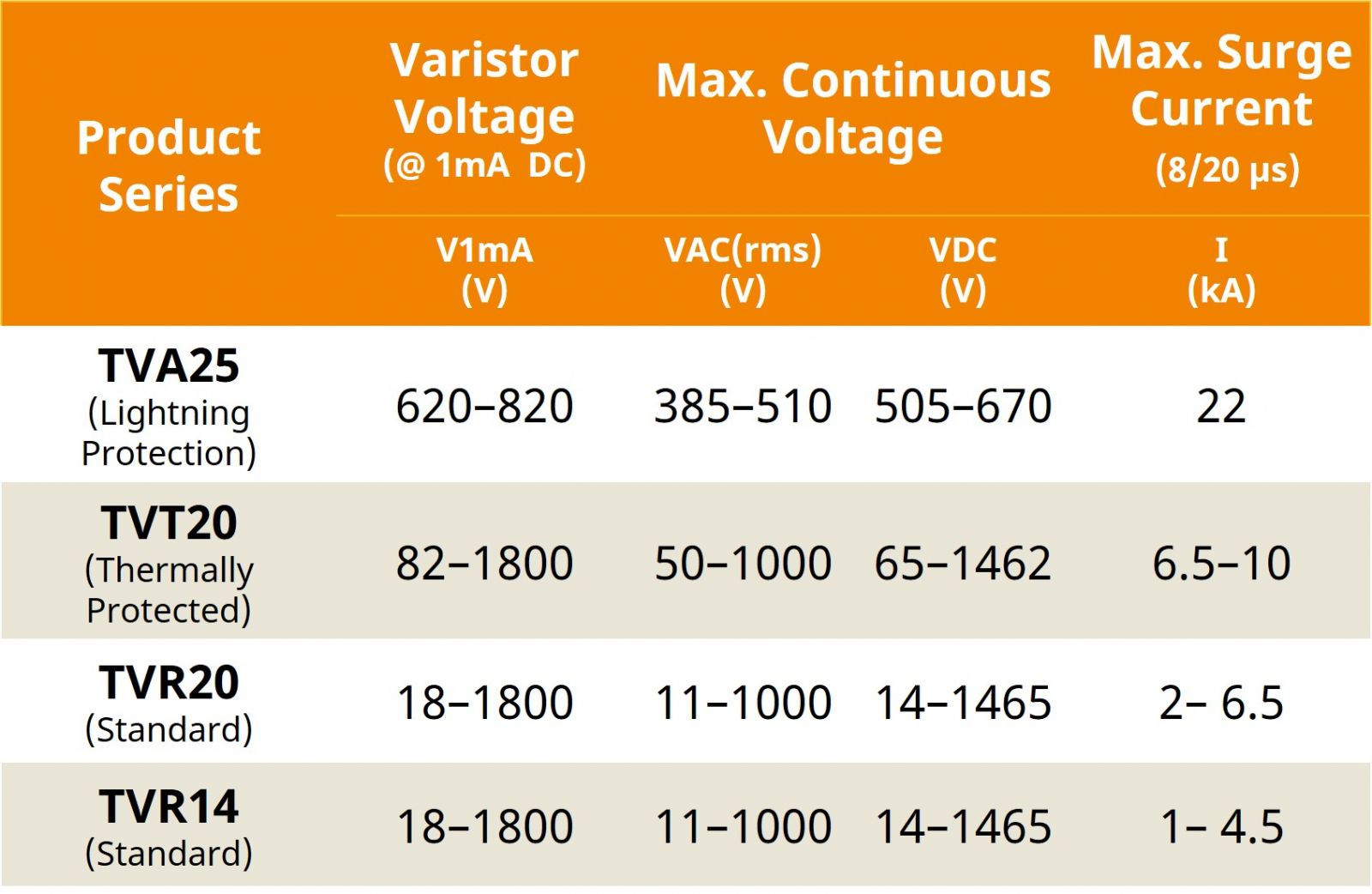
Gas discharge tube
Its high insulation resistance, very low capacitance, and high surge current handling capabilities make gas discharge tube (GDT) an optimal choice for protecting AC lines against lightning and other power surges. THINKING GDTs are available in various surface mount and leaded configurations and in a wide range of DC spark-over voltages to meet the needs of a broad range of applications. Among them, the two-electrode type GDT is often used for line-to-ground or line-to-line protection.
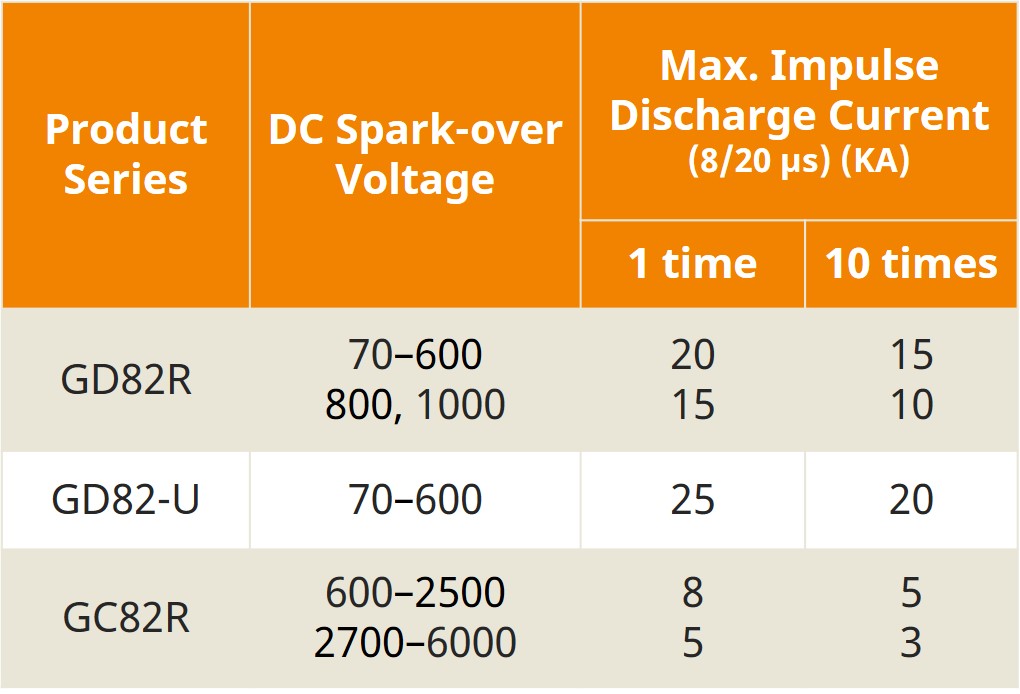
Over-Current Protection
Cermaic PTC Thermistor for Inrush Current Limiting
When the charging station is powered-up, a high peak inrush current flows into the equipment, which can harm the semiconductors or other components. THINKING recommends using a ceramic PTC thermistor as an inrush current limiter to limit this abnormal current. A ceramic PTC thermistor is a thermally sensitive semiconductor mainly made of ceramic. The ceramic PTC thermistor has relatively low resistance values at room temperature. However, as current passes through the thermistor and generates heat, its resistance significantly increases at a specified temperature point. This unique property makes PTC thermistor an ideal solution for over-current protection. The PPL and PSB series of THINKING ceramic PTC thermistors can limit inrush currents and provide robust protection for the power supply circuit.
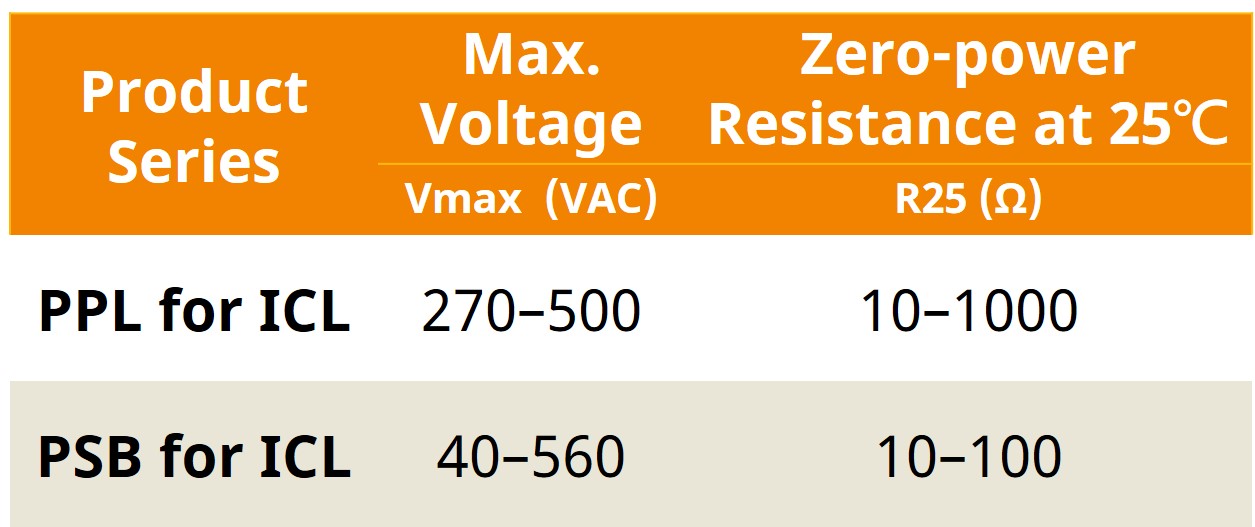
Cermaic PTC Thermistor for discharging capacitor
Besides serving as an inrush current limiter, ceramic PTC thermistors can also be used to discharge high-voltage capacitors in DC charging stations. Because the high-voltage energy stored in capacitors can cause electrical shock even when the power supply has been disconnected, designers should integrate appropriate discharge mechanisms into the circuit. Incorporating the ceramic PTC thermistor to discharge capacitors is a safe, effective, and reliable choice. Ceramic PTC thermistor can withstand high voltages and absorb excessive energy because of its material properties. Compared with using a fixed resistor as a discharging resistor, ceramic PTC thermistor has a higher voltage-withstanding capability and require fewer components than fixed resistors, which can significantly save board space and reduce overall costs. Customers can choose from different resistance values and voltage ratings for ceramic PTC thermistors offered by THINKING.
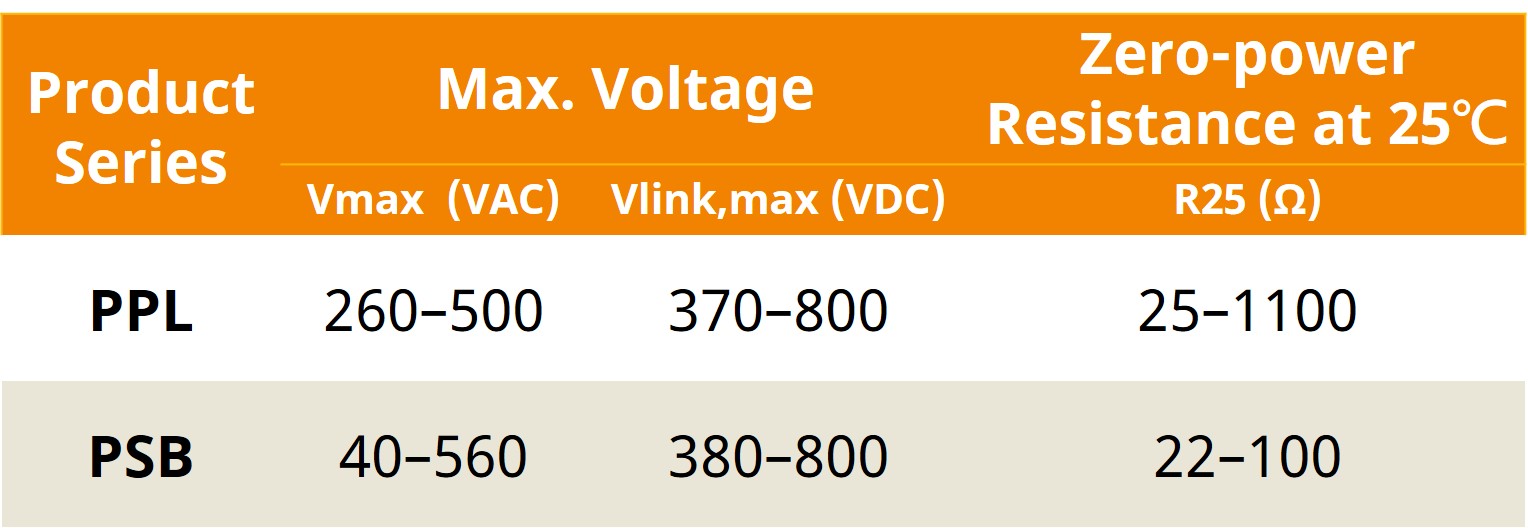
Over-Temperature Protection
Since DC charging stations require AC-DC conversion, more power semiconductor devices, such as MOSFETs and IGBTs, are utilized in the power conversion modules. Power semiconductors generate heat when operating and require temperature monitoring to prevent high transistor junction temperatures. Using NTC temperature sensors to monitor the temperature of semiconductor devices can help ensure these sensitive and valuable semiconductor components stay at their optimal operating temperatures.
There are various configurations of THINKING NTC temperature sensors to meet different design requirements. The NTSE series is an epoxy-coating type temperature sensor with a small sensing top, a simple structure, and high commonality. The NTSA series ring terminal temperature sensors are available in a wide range of terminal sizes (M2.5 to M10) and can be fastened with simple screw-on installation. Finally, the surface-mount type temperature sensor, TSM series, is small, lightweight, fast in response, and suitable for automated production to improve customers' production efficiency.
Public AC or DC charging stations installed in commercial spaces such as malls, office buildings, and highway service areas usually have communication interfaces and human-machine interfaces such as touchscreen, which can be threatened by ESD (Electrostatic Discharge) transients. When users interact with the touchscreen, the ESD transients are introduced into the charging equipment via the touchscreen and can potentially damage the ICs. Therefore, comprising the interface circuits with a robust ESD suppression solution is critical. The LCP series and ESD TVS are ideal ESD protection devices with low capacitance and fast response. Their ability to suppress rapid-rising ESD voltage transients without introducing additional capacitance helps keep signal integrity intact.
Electric vehicles need a charging cable for connection, whether slow AC or DC fast charging. A charging cable's power contact, particularly that of a DC high-power charging cable, transmits a high current that may generate significant amounts of heat during charging and endanger the user's safety. Therefore, integrating a temperature sensor at each DC contact to monitor its operating temperature is essential for ensuring the safety of high-speed charging. Once the power contact temperature exceeds a designated value, the charge controller of the charging station will stop the charging process or reduce the charging power to protect the user, the vehicle, and the charging equipment.
THINKING provides a variety of accurate NTC and platinum temperature sensors that are suitable for integrating with the power contacts to meet the design requirements of various types of AC slow charging and DC fast charging cables. In addition, for DC charging guns of high-voltage applications, THINKING can provide temperature sensors with high dielectric strength (>3500VAC) to ensure the stability and reliability of the charging process.
NTC temperature sensors include the epoxy-coating NTSE series and the screw-on NTSA series. Platinum (Pt) temperature sensor has positive temperature coefficient characteristics and excellent accuracy and stability in harsh environments. THINKING’s platinum temperature sensors for EV charging cables are available in different packaging. The Pt1000 chip can be enclosed in a metal housing, plastic case, or dual-layered heat-shrink sleeve to meet various requirements.
‧
In addition to temperature sensors, THINKING offers a broad line of circuit protection components to protect the latest appliances. Click here to see circuit protection recommendations for home appliances.
‧ Most temperature sensor types can be delivered in various shapes and with a wide choice of casing materials, cable lengths, connectors, terminals and mounting features to meet different application needs. Alternative resistances tolerances, R/T characteristics, resistance ratings, and UL recognized models are available on request. Please contact us to learn more about temperature sensors.

